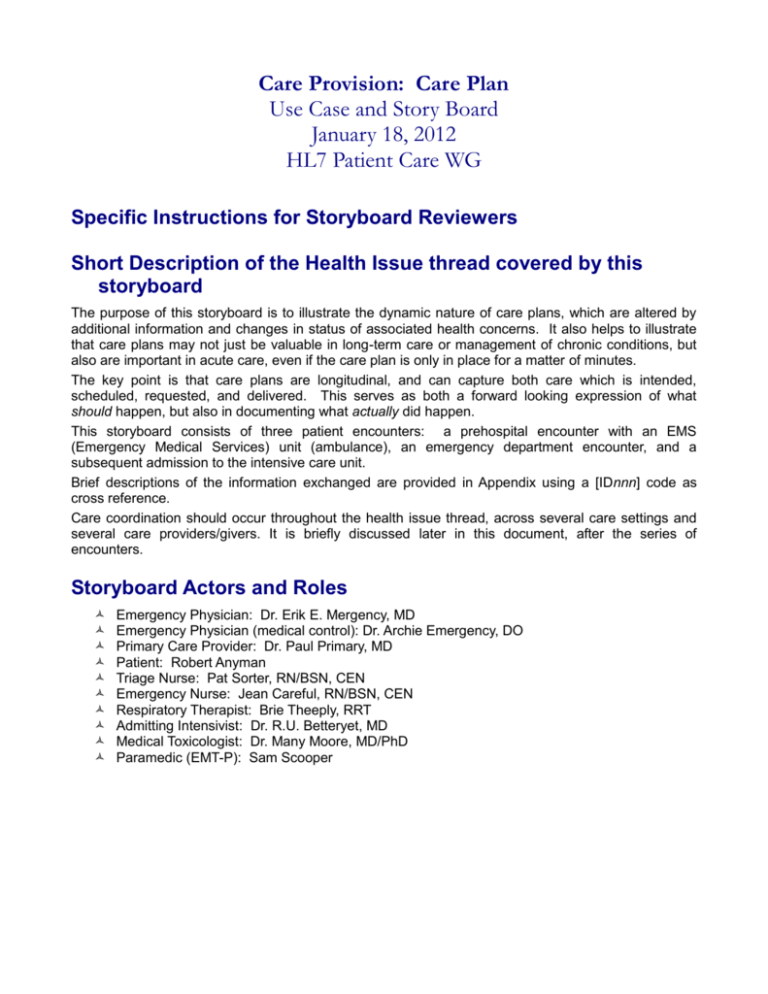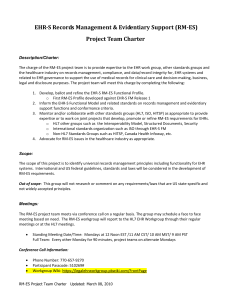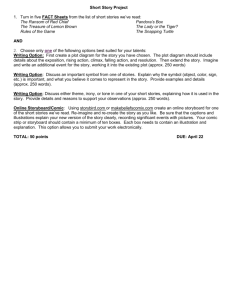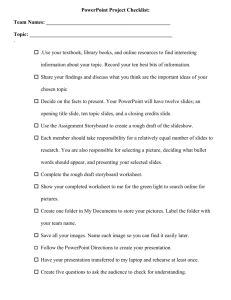Appendix C: Concept of Care Planning Integration
advertisement

Care Provision: Care Plan Use Case and Story Board January 18, 2012 HL7 Patient Care WG Specific Instructions for Storyboard Reviewers Short Description of the Health Issue thread covered by this storyboard The purpose of this storyboard is to illustrate the dynamic nature of care plans, which are altered by additional information and changes in status of associated health concerns. It also helps to illustrate that care plans may not just be valuable in long-term care or management of chronic conditions, but also are important in acute care, even if the care plan is only in place for a matter of minutes. The key point is that care plans are longitudinal, and can capture both care which is intended, scheduled, requested, and delivered. This serves as both a forward looking expression of what should happen, but also in documenting what actually did happen. This storyboard consists of three patient encounters: a prehospital encounter with an EMS (Emergency Medical Services) unit (ambulance), an emergency department encounter, and a subsequent admission to the intensive care unit. Brief descriptions of the information exchanged are provided in Appendix using a [IDnnn] code as cross reference. Care coordination should occur throughout the health issue thread, across several care settings and several care providers/givers. It is briefly discussed later in this document, after the series of encounters. Storyboard Actors and Roles Emergency Physician: Dr. Erik E. Mergency, MD Emergency Physician (medical control): Dr. Archie Emergency, DO Primary Care Provider: Dr. Paul Primary, MD Patient: Robert Anyman Triage Nurse: Pat Sorter, RN/BSN, CEN Emergency Nurse: Jean Careful, RN/BSN, CEN Respiratory Therapist: Brie Theeply, RRT Admitting Intensivist: Dr. R.U. Betteryet, MD Medical Toxicologist: Dr. Many Moore, MD/PhD Paramedic (EMT-P): Sam Scooper Storyboard Content Description of Primary Care Provider Encounter Pre-condition Mr. Anyman is a 26 year-old married man with a history of migraine headaches, who presents to his regular physician (Dr. Primary) with a month of symptoms of depressed mood, irritability, early morning awakening (terminal insomnia), and loss of enjoyment of social activities. He has some problems with work, particularly getting to work on time in the morning. His only chronic medications are atenolol 25 mg qDay for migraine headache prophylaxis, ibuprofen and sumatriptan for abortive therapy of migraines. Description of Evaluation and Management Dr. Primary performs a history and physical examination, as well as administers two standardized assessment scales for depression severity (PHQ-9 and HADS) [ID001, ID002]. He prescribes a SSRI class antidepressant as part of order sets and a care plan for major depressive disorder in adults. [ID003]. The plan includes a referral to a non-physician mental health provider for evaluation for cognitive behavior therapy, the initiation of a SSRI antidepressant, screening for suicide risk [ID004], screening for substance abuse [ID005], and a follow up visit in four weeks. Dr. Primary discusses the nature of depression, and asks Mr. Anyman to consider which symptoms are most bothersome and use these to set goals. Mr. Anyman indicates that sleep related issues and difficulty waking up in the morning were the biggest problem, and his wife had expressed some concern that he was shaving, showering and dressing more professionally less often than desired. These are agreed upon goals [ID006]. Post-condition Both the PHQ-9 and HADS indicate moderately severe depression, the screen for suicide indicates low risk, and the substance abuse screen indicates occasional binge drinking. The patient is given information regarding community resources, a copy of The Feeling Good Handbook, and a referral to a therapist [ID007] which is included in his insurance coverage, as well as suicide precautions, and the link to the practice's patient portal, where he is asked to do on-line PHQ-9 and HADS. An electronic prescription for a months worth of citalopram 20 mg qDay #30, and temazepam 15 mg qHS prn #6 [ID008] After he schedules a follow up visit, and an initial evaluation with the therapist he is discharged to home [ID009]. Description of Second Outpatient Encounter Pre-condition Soon after starting on the SSRI. Mr. Anyman noted increasing frequency and severity of headaches. These were similar to his usual migraine headaches, and on three occasions had to leave work or call in sick due to severity. Description of Clinic Visit #2 Evaluation and Management Dr. Primary determines that the citalopram is a likely cause, and discontinues the medication, noting a possible adverse reaction to the medication. Nortriptyline 25 mg PO qHS, with increasing doses every few days to a target dose of 150 mg is prescribed for both depression (and insomnia) and migraine headache prophylaxis. [ID010] Post-condition Self-care instructions updated to indicate need to track orthostatic symptoms, arise slowly from bed to avoid syncope, and methods for mitigation of anticholinergic symptoms. [ID011] Updated prescriptions sent electronically, and patient's care plan tracking method (part of patient record) updated with new goal (to return to full function without headaches). [ID012] Notice sent to mental health provider, updating the referral letter. [ID013] Emergency Medical Services and Prehospital Care Precondition The patient's wife has called for an ambulance after he took an overdose of tricyclic antidepressants (TCA) he had been prescribed for migraine prophylaxis and depression. The EMS unit consists of a basic emergency medical technician (EMT-B) and Mr. Sam Scooper, the paramedic (EMT-P). Dr. Mergency is working in the community hospital where the EMS agency routinely transports critically ill patients. Dr. Archie Emergency provides on-line medical control for the EMS unit after their initial evaluation of the patient. Several standing orders [ID014] are in place in both the emergency department and the EMS unit which define specific actions to take, given a particular set of preconditions. Description of EMS Evaluation and Transportation The patient has a mild tachycardia, is somewhat agitated, is confused as to date/time and circumstances why they took the overdose. The paramedic contacts the regional poison control center, who advises they to administer activated charcoal. The paramedic contacts medical control (Dr. Emergency) who orders physical restraints as needed, and starting an intravenous line with normal saline if it will not delay transport. Cardiac and vital sign monitoring is established en route to the hospital with an ETA of 5 minutes. Post-condition The patient's depression care plan is currently in limbo, as more pressing items supplant the requirements. The paramedic documents the new care plan, consisting of 4 point soft restraints, oral administration of activated charcoal, monitoring, establishing intravenous access, and transportation to the nearest emergency department. Description of Emergency Department Encounter Pre-condition The patient arrives to the emergency department and is triaged into a high acuity bed. The initial set of vital signs obtained by the paramedic en route to the ED shows HR 106, BP 134/88, RR 18, SaO2 99% on room air. The patient has not complied with requests to consume the activated charcoal by mouth. Description of ED Course The initial care plan is dictated by standardized procedures for a potentially suicidal patient and for a potential drug ingestion. Upon entry of the potential ingestion, specific orders are added to care plan. This includes a 12 lead ECG, comprehensive metabolic profile, serum acetaminophen level, serum aspirin level, activated charcoal, urinalysis, serum TCA level, blood alcohol level, urine toxicology screen, intravenous line with normal saline. The 12 lead ECG and activated charcoal administration are automatically triaged as the highest priority activities. These occur in conjunction with establishing vascular access, drawing blood, reattaching restraints. The patient continues to balk at swallowing the activated charcoal, and a nasogastric tube is added to the care plan to administer it. However, the care plan components detect a potential risk of aspiration with placement of the nasogastric tube, as well as several other “contraindicated procedures and drugs” which are called out in the care plan as potentially detrimental. The ECG is reviewed by Dr. Mergency while Jean Careful coaxes Mr. Anyman to drink the charcoal. The ECG reveals a sinus tachycardia with a HR of 134, QRS of 110 ms, and QTc of 420 ms. The plan is updated and a bicarbonate drip is ordered from the pharmacy and a bolus of sodium bicarbonate ordered. As that is being prepared, Mr. Anyman has a seizure. The care plan continues to function, with a bolus of sodium bicarbonate ordered in response to the wide complex tachycardia which appeared shortly after the onset of the seizure. Dr. Mergency requests that the patient be prepared for intubation as he orders intravenous lorazapam to combat the seizure. The intubation care plan includes multiple drugs which are weight adjusted automatically by the emergency department information system. Current medications and health concerns (including allergies) are queried from the health information exchange to facilitate the decision support system. The wide complex tachycardia converts into a sinus tachycardia after the first dose of sodium bicarbonate. The patient is given intravenous fentanyl, lidocaine, and a low doe of vecuronium. The care plan includes an automatic request for respiratory therapy to set up a ventilator, arterial blood gases, and a portable chest radiography. After succinylcholine and 10 mg of midazolam (given because the lorazepam could not be located quicker than the vial of midazolam in the intubation drug box) the placement of the tube confirmed by EtCO2. Once the last of the intubation care plan items were completed, the ventilator management care plan was finalized with ventilator settings and continued sedation. To monitor for recurrent seizures the plan was adapted to exclude ongoing neuromuscular blockade. Vital signs showed a continued sinus tachycardia with a HR of 136, BP of 102/62, SaO2 of 100% on FiO2 of 0.5 and MMV of 10L/min. The bicarbonate infusion is begun at a rate of 150 cc/hr, and a medical toxicology consultation instantiated to discuss need of continual lidocaine infusion. An orogastric tube is placed, and activated charcoal administered. Repeat blood pressure measurement shows a HR of 132, BP 90/42. The care plan is adapted, as the decision support system advises rechecking a 12 lead ECG, and giving another bolus of bicarbonate if the QRS is widened. Otherwise a norepinephrine infusion is prepared and the care plan adapted to titrate to a MAP > 70. Blood gasses show a mixed respiratory and metabolic alkalosis with a pH of 7.5. Post-condition The patient has multiple care plans in place: titration of norepinephrine and bicarbonate infusion to manage hemodynamics; bicarbonate infusion, hyperventilation and bicarbonate infusion to manage the TCA toxicity (by reducing the free TCA, as binding to albumin occurs at alkaline pHs), as well as multiple dose activated charcoal. Sedation for ventilation is ongoing with fentanyl and midazolam. Description of Admission to the ICU and Medical Toxicology Consultation Pre-condition Description of ED Evaluation and Management Post-condition Provider Paramedic Triage nurse Emergency department nurse Emergency physician Respiratory therapist Medical toxicologist Intensive care physician Activities EHR-S Interactions Communications Psychiatric Evaluation and Management Pre-condition Description of ED Evaluation and Management Post-condition Coordination of Care Association with Health Concerns Goals, Goal Evaluation, and Goal Criteria Acute Care Plan Storyboard Appendix A: Definitions and Glossary Page 7 of 10 Acute Care Plan Storyboard Appendix B: Information Created and Exchanged Information ID Description ID001 Hospital Anxiety and Depression Scale assessment instrument.1 ID002 Patient Health Questionnaire.2 ID003 Documentation of encounter, including presenting problem, reason for visit, history of present illness, review of systems, physical examination, past medical history, problem list, medication list, allergies/intolerance, medical decision making (including differential diagnosis), and plan. While the planning function is quite basic in most EHR-S, this envisions giving a provider a user-interface which links options for management to the various diagnosis. Presumably, much of the historical data is pulled from the EHR-S and pre-populates the relevant sections of the encounter document. ID004 Suicide risk assessment instrument ID005 Substance abuse screening instrument ID006 Goals and criterion worksheet ID007 Mental health referral and consultation request ID008 Electronic prescription / medication order ID009 Non-HL7 format calendar reminders (optional) sent to patient's groupware/calendar software (e.g. iCal format), as well as to clinical schedule system. ID010 Documentation of encounter ID011 ID012 ID013 1 2 Refs to HL7 assessment instrument specifications www.integration.samhsa.gov/images/res/PHQ%20-%20Questions.pdf Page 8 of 10 Acute Care Plan Storyboard Appendix C: Concept of Care Planning Integration star t CC/PP/RfV entry Problem specific HPI template, which includes notions of desired outcomes and goals Onset: Duration: Severity: Associated symptoms: ROS and Exam findings driven by Decision support system: possible treatment, prior evaluation ⊕⊘±? Lone acute severe headache ⊕⊘±? Recent lumbar puncture ⊕⊘±? H/O angle closure glaucoma DDX generated and documented Further testing and treatment stated as 'intents' in documentation of the impression and care plan. Tension headache v. migraine v. adverse drug reaction Intend to stop SSRI DDX generated and documented Further testing and treatment stated as 'intents' in documentation of the impression and care plan. EHR-S EHR-S EHR-S EHR-S EHR-S submits encounter appointment request processes encounter appointment proposals generates orders for editing/signing prompts for goals and criterion workflow schedules and assigns tasks EHR-S monitors task progress over time EHR-S monitors data and compares to criterion EHR-S monitors for specific events Page 9 of 10 Acute Care Plan Storyboard Appendix D: References Page 10 of 10





